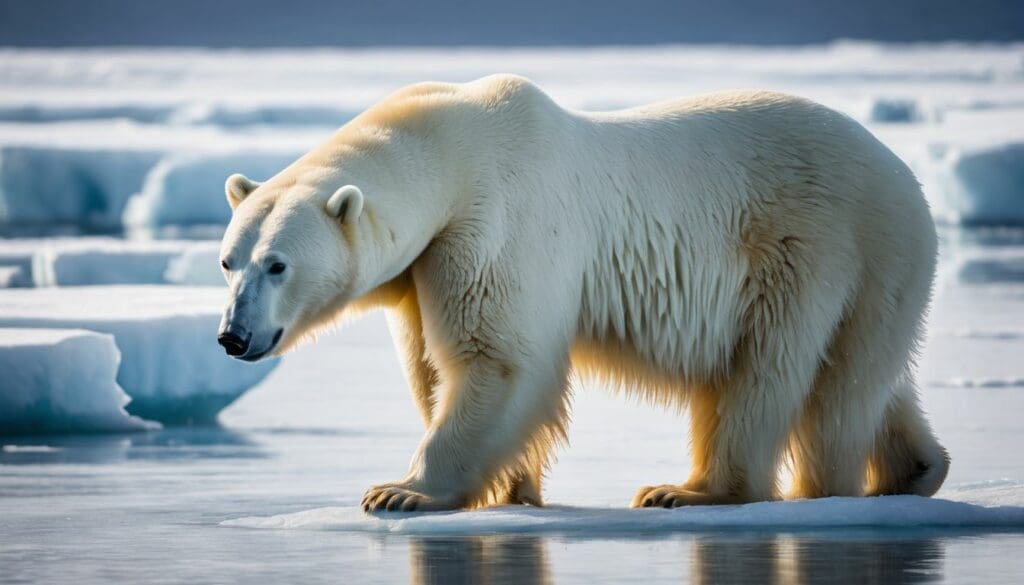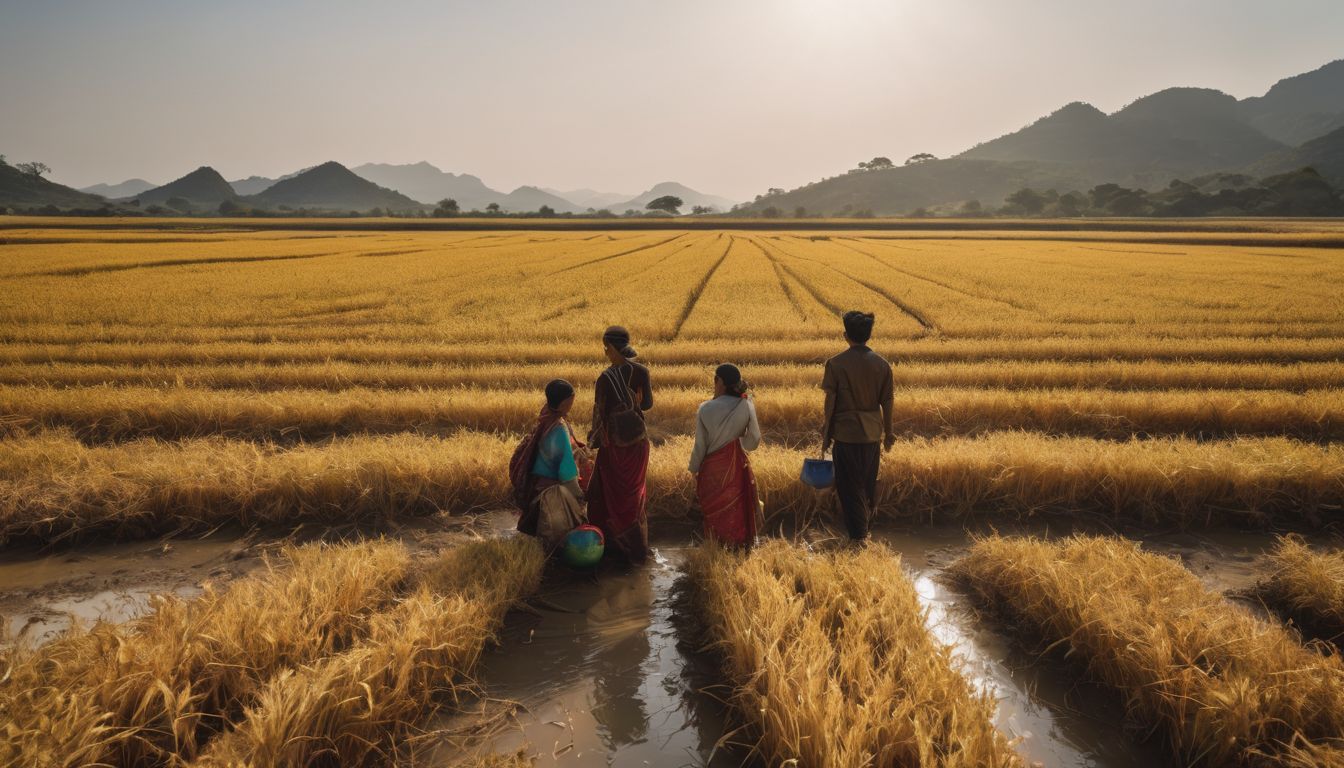Many of us worry about the fate of animals as our world heats up. In fact, global warming is pushing many species to the edge, with some facing severe threats to their survival. This article will shine a light on these challenges and explore ways we can protect our wildlife from the rising temperatures.
Read on, and let’s tackle this hot topic together!
Key Takeaways
- Global warming is causing serious disruptions to wildlife habitats, leading to species migration changes and possible extinction due to the inability to adapt.
- Rising sea levels, habitat loss, and increased disease rates directly linked to climate change are putting significant stress on various animal populations including polar bears, sea turtles, birds, and fish.
- Changes in climate conditions result in shifts in food and water availability for wildlife; this is forcing alterations in life cycle events like mating seasons and hibernation periods which can affect ecosystem balance.
- Active conservation efforts are necessary to mitigate the effects of global warming; these include protecting natural habitats, reducing carbon emissions through sustainable practices, supporting renewable energy initiatives and educating the public about environmental issues.
- Individuals can make a difference by adopting eco-friendly habits such as conserving energy at home and advocating for policies that aim at preserving biodiversity against climate-related threats.
What is global warming and how does it affect wildlife?
Global warming is the gradual increase in the Earth’s temperature due to human activities such as burning fossil fuels and deforestation. This leads to habitat disruption, increased disease rates, and changes in species themselves, all of which have a significant impact on wildlife.
Habitat disruption
Climate change is reshaping the world’s habitats at an alarming rate, leading to significant ecosystem disruption. Forests, wetlands, and coral reefs are facing severe challenges as temperatures rise and weather patterns shift.
Animals that depend on these environments struggle to survive as their homes become unrecognisable or vanish entirely.
Species migration patterns are thrown off course due to disrupted habitats, while others face extinction when they can’t adapt quickly enough. With biodiversity loss escalating, the intricate web of life that sustains various species—including humans—is under threat.
Conservation biology aims to understand and mitigate these impacts, but habitat destruction outpaces these efforts in many regions globally.
Increased disease rates
Global warming has led to an increase in disease rates among wildlife. Higher temperatures and changes in precipitation patterns have contributed to the spread of diseases, affecting various species across different ecosystems.
As a result, populations of vulnerable animals are facing additional threats from illnesses that were once contained within specific areas. The changing climate has disrupted the natural balance of ecosystems, allowing certain diseases to thrive and propagate, posing a significant risk to biodiversity.
The rising disease rates among wildlife due to global warming necessitate urgent action towards environmental conservation and sustainable practices. It is crucial for individuals and communities to support efforts aimed at mitigating climate change’s impact on wildlife health while promoting ecological balance through collective conservation initiatives.
Changes in species themselves
Climate change is causing significant shifts in the characteristics and behaviors of many species. Some animals are growing smaller, while others are experiencing changes in migratory patterns, reproductive cycles, or even becoming more aggressive in their search for food and water.
As temperatures rise and ecosystems transform, these alterations can have far-reaching impacts on the delicate balance of natural habitats.
Adaptations within species are vital for survival as they strive to cope with the changing environmental conditions. These adjustments can lead to both positive and negative consequences for biodiversity.
Understanding how climate change affects species directly helps in devising effective conservation strategies that mitigate the threats wildlife faces due to global warming.
Specific Impacts of Global Warming on Wildlife
Rising sea levels and habitat loss are threatening the survival of many species, leading to range shifts and changes in food and water availability. Moreover, global warming is also contributing to an increase in pests and diseases, as well as altering the timing of life cycle events for many wildlife populations.
Rising sea levels
Rising sea levels due to global warming threaten the existence of coastal wildlife by inundating crucial habitats. Species like sea turtles and shorebirds find their nesting grounds swallowed by encroaching waters, while mangrove forests vital for many marine species face submersion.
As seas rise, salinity levels increase, affecting fish populations and disrupting entire ecosystems. Furthermore, the loss of these critical habitats results in reduced food sources and breeding grounds for numerous species, leading to population declines.
The impact of rising sea levels on wildlife presents an urgent need for action to mitigate climate change effects. Protection and restoration efforts must focus on preserving coastal habitats such as wetlands, salt marshes, and coral reefs that play essential roles in supporting a diverse array of wildlife.
Habitat loss
Climate change is leading to habitat loss for many species across the globe. Rising sea levels resulting from global warming are causing coastal habitats to disappear, threatening the survival of numerous wildlife species.
This loss of habitat disrupts ecosystems and endangers the existence of various plants and animals that depend on these crucial environments for their survival.
As temperatures continue to rise, habitats are changing, making it challenging for many species to adapt. This disruption in habitats not only affects individual species but also has a profound impact on entire ecosystems, leading to a decline in biodiversity and putting numerous wildlife populations at risk of extinction.
Range shifts
Wildlife species are on the move, shifting their ranges in response to changing climate conditions. This shift involves animals moving to areas with more suitable temperatures and resources, leading to potential conflicts with other species or altered ecosystem dynamics.
For instance, some bird species are migrating earlier due to warmer springs, impacting the availability of food for other wildlife populations.
As wildlife adapts by shifting its range, it’s crucial for conservation efforts to monitor these changes and ensure that appropriate habitats are protected. Understanding and managing these range shifts can help mitigate negative impacts on biodiversity while promoting ecosystem resilience in the face of a changing climate.
Changes in food and water availability
Global warming brings changes in food and water availability, affecting wildlife. Shifts in temperature and precipitation alter the abundance and distribution of plants, impacting what animals have to eat.
Additionally, rising temperatures impact water sources, leading to scarcity or changes in quality that can affect aquatic species like fish and amphibians. These alterations pose challenges for many species as they struggle to adapt to new environments with changed resources.
Furthermore, climate change shifts the timing of seasonal events such as flowering or migration, disrupting the synchronisation between animals and their food sources. This impacts the survival of various species relying on specific seasonal foods or conditions.
Increase in pests and disease
Global warming has led to an increase in pests and disease among wildlife due to changing temperature patterns. This affects both terrestrial and aquatic species, leading to widespread impacts on ecosystems.
Rising temperatures create favorable conditions for the proliferation of pests, causing harm to plants and animals, while also increasing the spread of diseases such as malaria and dengue fever among wildlife populations.
Moreover, higher temperatures can disrupt natural predator-prey relationships, leading to uncontrolled population growth of certain species. This can result in imbalances within ecosystems that threaten the survival of various plant and animal species.
Changes in the timing of life cycle events
As global temperatures rise, wildlife is experiencing changes in the timing of their life cycle events. Mating seasons, migration patterns, and hibernation periods are all being affected by the shifting climate.
This disruption can lead to mismatches with food availability, impacting species’ survival and reproductive success.
In response to warming temperatures, many species are adjusting their life cycle events. However, some are struggling to adapt quickly enough to keep up with the changing environmental cues.
Examples of Wildlife Affected by Global Warming
Polar bears, sea turtles, birds, and fish are just a few examples of wildlife that are feeling the impact of global warming. Find out more about how these species are being affected by reading on.
Polar bears
Polar bears face a direct threat from the impact of global warming. The melting of Arctic sea ice has led to reduced access to their main prey, seals, resulting in increased starvation and population decline.
As sea ice diminishes due to climate change, polar bears are forced to travel longer distances and spend more time on land, leading to higher energy expenditure and decreased reproductive success.
The shrinking ice also means fewer denning opportunities for females, further impacting cub survival rates. With rising temperatures causing profound changes in the Arctic ecosystem, polar bears are at risk of losing their habitat and facing an uncertain future.
Sea turtles
Sea turtles face multiple challenges due to global warming. Rising sea levels threaten their nesting habitats, and changes in temperatures can affect the sex of hatchlings. Sea turtle populations are also at risk from habitat loss and altered food sources caused by climate change.
The increased frequency of extreme weather events may also negatively impact these creatures, making it crucial to address the effects of global warming on sea turtle survival.
By addressing the impacts of global warming on sea turtles, we can help protect these endangered species for future generations. Supporting conservation efforts and promoting sustainable practices will play a vital role in safeguarding their habitats and ensuring their long-term survival.
Birds
Birds are being significantly impacted by global warming. Changes in temperature and weather patterns are affecting their breeding, migration, and feeding habits. As a result, some bird species are facing challenges in finding suitable habitats while dealing with changes in food availability.
Additionally, climate change is causing alterations to the landscapes where birds live and disrupting the delicate balance of their ecosystems.
Many bird populations have experienced shifts in their ranges due to rising temperatures and changing habitats. This has led to conflicts with other species competing for limited resources and has put additional pressure on already vulnerable bird populations.
Fish
Fish populations are being significantly impacted by global warming. Higher water temperatures affect the survival and reproduction of fish species, leading to a decline in their numbers.
Additionally, changes in ocean currents and habitats disrupt the natural life cycles of many fish species, further endangering their populations. Ecosystems that rely on fish as a primary food source are also at risk due to these disruptions.
Solutions and Ways to Help Stop Global Warming’s Impact on Wildlife
Reducing carbon emissions, protecting habitats, promoting sustainable practices, supporting conservation efforts, and educating others on the issue are all crucial steps in mitigating the impact of global warming on wildlife.
These actions can help preserve and protect various species from the negative effects of climate change.
Reduce carbon emissions
Decreasing carbon emissions is crucial in mitigating the impact of global warming on wildlife. By reducing our reliance on fossil fuels and transitioning to cleaner energy sources, we can lower the amount of greenhouse gases released into the atmosphere, thus slowing the pace of climate change.
Supporting renewable energy initiatives and advocating for sustainable transportation options are effective ways to cut down on carbon emissions. Additionally, promoting energy efficiency measures in homes and businesses can contribute to a significant reduction in overall carbon output.
Taking proactive steps to minimise our carbon footprint is essential for safeguarding wildlife from further habitat disruption and other detrimental effects of climate change. More efforts towards reducing carbon emissions will help protect vulnerable ecosystems and preserve biodiversity for generations to come.
Protect habitats
Protecting habitats is crucial in mitigating the impact of global warming on wildlife. Conservation efforts such as establishing protected areas, creating wildlife corridors, and restoring degraded habitats can provide safe spaces for vulnerable species to thrive.
By safeguarding natural ecosystems, we can help maintain biodiversity and ensure the survival of various animal species facing habitat loss due to climate change.
Furthermore, promoting sustainable practices in land use and resource management is essential for preserving critical habitats and minimising human-induced disturbances. Encouraging responsible stewardship of natural resources will also contribute to reducing environmental stressors that threaten the well-being of wildlife populations.
Promote sustainable practices
Promoting sustainable practices is crucial in mitigating the impact of global warming on wildlife. By reducing carbon emissions, conserving energy, and supporting eco-friendly initiatives, individuals can contribute to a healthier planet for all species.
Protecting habitats and advocating for environmentally responsible policies are key steps towards preserving biodiversity and ensuring the survival of vulnerable wildlife populations.
Supporting sustainable practices not only protects wildlife but also safeguards the delicate balance of our ecosystems. It’s essential for everyone to take an active role in promoting sustainability to ensure a better future for our planet and its inhabitants.
Support conservation efforts
To mitigate the impact of global warming on wildlife, supporting conservation efforts is crucial. By actively participating in or donating to conservation organisations, individuals can help protect and restore habitats for vulnerable species.
Additionally, promoting sustainable practices such as reducing carbon emissions and protecting natural environments are essential steps in safeguarding wildlife from the adverse effects of climate change.
By taking action to support conservation efforts, we can play a vital role in preserving the planet’s biodiversity for future generations. This proactive approach will contribute to creating a more sustainable and resilient ecosystem that benefits both wildlife and humans alike.
Educate others on the issue
Raise awareness about the impact of global warming on wildlife. Share information on how climate change affects habitats, species survival, and disease rates in animals. Encourage support for conservation efforts and sustainable practices to help mitigate the negative effects of global warming on wildlife populations.
Conclusion
In conclusion, global warming is having a devastating impact on wildlife around the world. Rising sea levels are threatening the habitats of many species, leading to habitat loss and range shifts.
Increased disease rates and changes in food and water availability are further exacerbating the challenges faced by wildlife. It is crucial for us to take action now to reduce carbon emissions, protect habitats, promote sustainable practices, support conservation efforts, and educate others on the issue in order to mitigate these impacts.
FAQs
1. How does global warming affect wildlife?
Global warming leads to habitat disruption, increases disease rates in wildlife, and can change species’ behaviors affecting their survival chances.
2. What are the effects of sea level rise on animals?
Sea level rise due to climate change destroys natural habitats for many species leading to loss of biodiversity and increased threats to wildlife.
3. Can global warming lead to extinction?
Yes, the impact of climate change on wildlife causes severe threats that can drive some animal species towards extinction if not addressed.
4. Why are higher water temperatures bad for fish populations?
Higher water temperatures resulting from global warming negatively impact fish populations by changing ecosystems and reducing available oxygen in the water.
5. Are animals able to adapt quickly enough to survive climate change?
While some wildlife may adapt over time, the rapid pace of climate changes due to global warming often threatens their ability to cope effectively with these new conditions.





